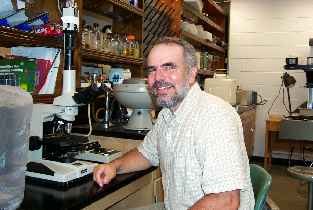 Cell-cell communication is an
indispensable aspect of multicellular development and several communication
systems are required to coordinate a variety of processes in developing M. xanthus
cells.
Cell-cell communication is an
indispensable aspect of multicellular development and several communication
systems are required to coordinate a variety of processes in developing M. xanthus
cells.
We are studying the role of cell-cell signaling in the control of developmental gene
expression by the bacterium Myxococcus xanthus. M. xanthus is unusual among
microbes in that hundreds of thousands of cells cooperate to form multicellular
structures (fruiting bodies) in which vegetative cells differentiate into spores. This
relatively simple system is appropriate for studying developmental problems of
relevance to higher animal and plant systems.  Cell-cell communication is an
indispensable aspect of multicellular development and several communication
systems are required to coordinate a variety of processes in developing M. xanthus
cells.
Cell-cell communication is an
indispensable aspect of multicellular development and several communication
systems are required to coordinate a variety of processes in developing M. xanthus
cells.
We are investigating the E-signaling system and how E-signaling functions in development to activate the expression of a particular group of genes. The steps that can be envisioned in this process include the production of a signal molecule, the transmission of that signal between cells, target cell reception of the signal via a specific receptor at the cell surface, transduction of reception stimulus into the target cell cytoplasm, and the activation of transcriptional regulatory systems to initiate developmental gene expression.
Currently an important goal of our research is to identify to E-signal. Genetic and physiological studies of a mutant defective in E-signal production have led to the hypothesis that the E-signal is one of the branched-chain fatty acids which are found in the membrane phospholipids of M. xanthus. We propose that this fatty acid is enzymatically released from phospholipid during fruiting body formation and that the fatty acid is then available for transmission to neighboring cells. A biological assay has been developed which will allow us to test components of wildtype cells for E- signaling activity. Using this assay it should be possible to purify and characterize the E-signal. The demonstration that a fatty acid functions in cell-cell signaling would be a novel finding opening the door to further studies of the fatty acids in diverse cellular processes.
Another focus of our research is to better understand the relationship between the structure of the M. xanthus cell surface and the ability of cells to carry out cell-cell communication. This research began with the observation that the E-signal defective mutant also lacks cell surface structures called fibrils. We have now isolated a collection of additional mutants with defects in fibril production and have found that while these mutants are phenotypically and genotypically distinct from the signaling mutant, they are all defective in fruiting body formation. This finding argues for an essential role for fibrils in multicellular development. Analysis of these mutants will enable us to identify the genes involved in fibril formation and to determine more precisely the role of these structures in development.
For more information about this program, email the Department or Dr. John Downard.